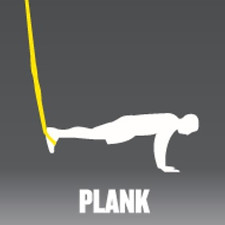top of page
TRX Foundational Movements
Every move in TRX is based on 7 functional moves. The same goes for TRX Yoga asanas - each pose is organised by the foundational movement that inspires it.
Every move is based on the active plank - neutral spine, level pelvis, alignment of the ears, shoulders, hips, knees and ankles, all held with full body tension and controlled diaphragmatic breathing.
Each move is based on the hinge - a neutral spine, maximum hip flexion and extension with minimal knee flexion and extension, plus a near vertical shin angle.
Each move combines two foundational movements:
Each move relies on hinge with a twist - the disassociation of the transverse plane motion between the shoulders and hips, also termed “X-Factor” in rotational activities.
Each move is based on the squat - begin at full hip extension with an active plank, tall spine, feet rooted into ground. Triple flexion of hips, knees and ankles, to lower hips toward the floor. Hips open at the bottom (no valgus collapse). On the return, hips and shoulders move together.
Each move is based on the lunge - vertical active plank and tall torso throughout, with front foot and rear ball-of-foot rooted into ground. Ankles, knees, and hips stay aligned. Both hips help to control deceleration (eccentric) and acceleration (concentric)
The backbend, defined—integrated hip flexion & extension coordinated with spine flexion/extension and dissociation of segments in the saggittal plane.
TRX Yoga Deep Rest
A few moments of stillness to provide a deep sense of relaxation. Traditionally done at the end of practice to allow the musculoskeletal and nervous system to integrate after movement.
bottom of page






